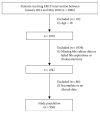Microbial Profiles and Risk Factors of Preexisting Biliary Infection in Patients with Therapeutic Endoscopy
- PMID: 31191641
- PMCID: PMC6525931
- DOI: 10.1155/2019/1527328
Microbial Profiles and Risk Factors of Preexisting Biliary Infection in Patients with Therapeutic Endoscopy
Abstract
Background: The bile infection may already exist before the administration of an interventional procedure, despite no clinical manifestations of cholangitis detected. Blood cultures remained negative even in more than half of the febrile cases with cholangitis. Risk factors associated with bacterial growth in bile before the intervention are not well defined. To establish the bacterial profiles isolated from the bile samples and to identify risk factors for bacterial colonization in the bile system.
Methods: Individuals who underwent endoscopic retrograde cholangiopancreatography (ERCP) interventions were enrolled. Bile samples were aspirated and were immediately transferred into a sterile tube for storage.
Results: Positive bile cultures were detected in 363 (38.0%) of 956 patients, including 322 benign diseases and 41 malignances. Of 363 positive cases, 351 (96.7%) were monoinfection and 12 (3.3%) multi-infection. Escherichia coli were the most common Gram-negative bacteria (210, 56.0%), followed by Klebsiella pneumoniae (45, 12.0%). Enterococcus faecalis represented the most common Gram-positive microorganism (19, 5.07%), while Candida albicans (11, 2.93%) were the dominant fungi. Klebsiella pneumoniae were more frequently detected in malignant diseases (P = 0.046). Age, previous ERCP history or OLT history, and CBD diameter were independent risk factors for positive cultures (P < 0.05) while preoperative jaundice drug therapy was the protective factor for bile infection (P < 0.05).
Conclusion: Monomicrobial infection was dominant among all infections, and Klebsiella pneumoniae strains were more frequently isolated from patients with malignant diseases. To effectively manage patients who are at a high risk for bile infection, a detailed diagnosis and treatment plan for each case should be prepared.
Similar articles
-
[Pathogens' distribution and changes of antimicrobial resistance in the bile of acute biliary tract infection patients].Zhonghua Wai Ke Za Zhi. 2021 Jan 1;59(1):24-31. doi: 10.3760/cma.j.cn112139-20200717-00559. Zhonghua Wai Ke Za Zhi. 2021. PMID: 33412630 Chinese.
-
Microbial profile of biliary tract infection in patients undergoing therapeutic endoscopic retrograde cholangiopancreatography (ERCP), and baseline risk factors predicting microbial growth and post-ERCP cholangitis.Prz Gastroenterol. 2024;19(3):296-302. doi: 10.5114/pg.2024.136226. Epub 2024 Mar 11. Prz Gastroenterol. 2024. PMID: 39802970 Free PMC article.
-
Microbiological study and antimicrobial susceptibility of bile in biliary therapeutic endoscopy.Tunis Med. 2015 Oct;93(10):602-5. Tunis Med. 2015. PMID: 26895121
-
Obstructive jaundice due to a blood clot after ERCP: a case report and review of the literature.BMC Gastroenterol. 2018 Nov 3;18(1):163. doi: 10.1186/s12876-018-0898-4. BMC Gastroenterol. 2018. PMID: 30390657 Free PMC article. Review.
-
[Antibiotic prevention and therapy of infectious complications in ERCP].Leber Magen Darm. 1992 Sep;22(5):173-6. Leber Magen Darm. 1992. PMID: 1406012 Review. German.
Cited by
-
Preventive Antibiotic Use and Complications After Endoscopic Retrograde Cholangiopancreatography in Patients Hospitalized for Primary Sclerosing Cholangitis.Cureus. 2024 Jul 12;16(7):e64429. doi: 10.7759/cureus.64429. eCollection 2024 Jul. Cureus. 2024. PMID: 39131042 Free PMC article.
-
Gallbladder Cancer Presenting as Mirizzi Syndrome Complicated by Rapidly Evolving 23 rRNA Gene-Linezolid Resistance with Vancomycin-Resistant Enterococcus Infection Resulting in Fatal Cholangial Sepsis.Case Rep Gastroenterol. 2020 Oct 28;14(3):540-546. doi: 10.1159/000508851. eCollection 2020 Sep-Dec. Case Rep Gastroenterol. 2020. PMID: 33250695 Free PMC article.
-
The distribution and antibiotic-resistant characteristics and risk factors of pathogens associated with clinical biliary tract infection in humans.Front Microbiol. 2024 May 9;15:1404366. doi: 10.3389/fmicb.2024.1404366. eCollection 2024. Front Microbiol. 2024. PMID: 38784792 Free PMC article.
-
The Great ESKAPE: Exploring the Crossroads of Bile and Antibiotic Resistance in Bacterial Pathogens.Infect Immun. 2020 Sep 18;88(10):e00865-19. doi: 10.1128/IAI.00865-19. Print 2020 Sep 18. Infect Immun. 2020. PMID: 32661122 Free PMC article. Review.
-
Bile Microbiota in Liver Transplantation: Proof of Concept Using Gene Amplification in a Heterogeneous Clinical Scenario.Front Surg. 2021 Mar 16;8:621525. doi: 10.3389/fsurg.2021.621525. eCollection 2021. Front Surg. 2021. PMID: 33796547 Free PMC article.
References
LinkOut - more resources
Full Text Sources


